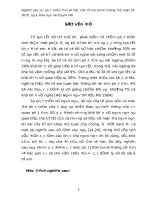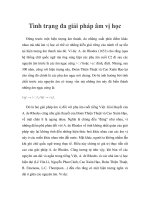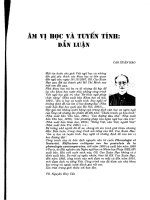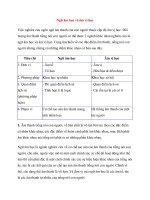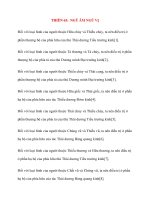15 ngu am am vi hoc
Bạn đang xem bản rút gọn của tài liệu. Xem và tải ngay bản đầy đủ của tài liệu tại đây (346.37 KB, 17 trang )
TRƯỜNG ĐẠI HỌC MỞ THÀNH PHỐ HỒ CHÍ MINH
KHOA NGOẠI NGỮ
TÀI LIỆU HƯỚNG DẪN ÔN TẬP VÀ KIỂM TRA
MÔN: NGỮ ÂM – ÂM VỊ HỌC
Mục đích
Tài liệu này nhằm hỗ trợ cho học viên hình thức giáo dục từ xa nắm vững nội dung ôn
tập và làm bài kiểm tra hết môn hiệu quả.
Tài liệu này cần được sử dụng cùng với tài liệu học tập của môn học và bài giảng của
giảng viên ôn tập tập trung theo chương trình đào tạo.
Nội dung hướng dẫn
Nội dung tài liệu này bao gồm các nội dung sau:
Phần 1: Các nội dung trọng tâm của môn học. Bao gồm các nội dung trọng tâm
của môn học được xác định dựa trên mục tiêu học tập, nghĩa là các kiến thức hoặc
kỹ năng cốt lõi mà người học cần có được khi hoàn thành môn học.
Phần 2: Cách thức ôn tập. Mô tả cách thức để hệ thống hóa kiến thức và luyện tập
kỹ năng để đạt được những nội dung trọng tâm.
Phần 3: Hướng dẫn làm bài kiểm tra. Mô tả hình thức kiểm tra và đề thi, hướng
dẫn cách làm bài và trình bày bài làm và lưu ý về những sai sót thường gặp, hoặc
những nỗ lực có thể được đánh giá cao trong bài làm.
Phần 4: Đề thi mẫu và đáp án. Cung cấp một đề thi mẫu và đáp án, có tính chất
minh hoạ nhằm giúp học viên hình dung yêu cầu kiểm tra và cách thức làm bài thi.
-1-
PHẦN 1. CÁC NỘI DUNG TRỌNG TÂM
A/ NGỮ ÂM HỌC (Phonetics)
Chương 1: Sự phát âm (The production of speech sounds)
Ba yếu tố của sự phát âm (Three main factors in the production of speech sounds).
Tuyến đi của âm (The vocal tract).
Thanh quản và các vị trí của thanh môn (Larynx – Positions of the glottis)
Chương 2: Nguyên âm (Vowels) và Phụ âm (Consonants)
Phân biệt nguyên âm vá phụ âm (Differences between vowels & consonants).
Nguyên âm (Vowels)
o Định nghĩa
o Phân loại
o Đặc điểm
Nhị trùng âm / Nguyên âm đôi (Diphthongs)
o Định nghĩa
o Phân loại
o Đặc điểm
Tam trùng âm /Nguyên âm ba (Triphthongs)
Phụ âm (Consonants)
o Định nghĩa
o Phân loại
Chương 3: Âm tắc (Plosives / Stops)
Định nghĩa.
Phân loại
Sơ đồ vị trí phát âm (Facial diagrams)
Đặc điểm
Chương 4: Âm xát và tắc xát (Fricatives & Affricates)
1. Âm xát
Định nghĩa.
Phân loại
-2-
Sơ đồ vị trí phát âm (Facial diagrams)
Đặc điểm
2. Âm tắc xát
Định nghĩa.
Đặc điểm
Chương 5: Âm mũi (Nasals) và những phụ âm khác (Other consonants)
1. Âm mũi (Nasals)
Định nghĩa.
Phân loại
Sơ đồ vị trí phát âm (Facial diagrams)
Đặc điểm
2. Âm bên (Lateral)
Định nghĩa
Đặc điểm
3. Âm tiếp cận (Approximants)
Định nghĩa
Đặc điểm
4. Bán nguyên âm (Semi-vowels) / Bán phụ âm (Semi-consonants)
Định nghĩa
Đặc điểm
B/ ÂM VỊ HỌC (Phonology)
Chương 6: Âm vị (Phonemes)
o Định nghĩa; Phân loại
o Dị âm (Allophones)
o Phân bố bổ sung (In Complementary Distribution) (In CD)
o Cặp từ nhỏ nhất (Minimal pairs)
o Ký âm (Transcription)
Chương 7: Âm tiết (Syllable)
Định nghĩa
Cấu trúc âm tiêt (Syllable structure)
-3-
Âm tiết mạnh và yếu (Strong & weak syllable)
Chương 8: Dấu nhấn
Tính chất của dấu nhấn (Nature of stress)
Các cấp độ dấu nhấn (Levels of stress)
Dấu nhấn trong từ (Stress within a word)
Từ đơn (Simple words)
Từ phức (Complex words)
Từ kép (Compound words)
Chương 9: Dấu nhấn trong câu
Chuyển dịch dấu nhấn (Shifting stress)
Các loại từ mang dấu nhấn trong câu (Types of words stressed in a sentence)
Chương 10: Dạng yếu của từ (Weak forms)
Dạng yếu và mạnh của từ
Chương 11: Liên kết âm (Connected speech)
Đồng hóa âm (Assimilation)
Lướt âm (Elision)
Nối âm (Linking)
Chương 12: Ngữ điệu (Intonation)
Định nghĩa
Chức năng
Cách biểu thị ngữ điệu trong câu
-4-
PHẦN 2. CÁCH THỨC ÔN TẬP
A/ NGỮ ÂM HỌC (PHONETICS)
Chương 1: Sự phát âm (The production of speech sounds)
Ba yếu tố của sự phát âm (Three main factors in the production of speech sounds).
Tuyến đi của âm (The vocal tract).
o Phân biệt các bộ phận phát âm và vị trí của chúng
Thanh quản và các vị trí của thanh môn (Larynx – Positions of the glottis)
o Nhận diện kết cấu của thanh quản: dây thanh (vocal cords/folds/bands);
thanh môn (glottis).
o Các vị trí của thanh môn và các âm tương ứng
Đọc tài liệu học tập chương 1
Làm bài tập: Test 1
Sau khi làm bài, dùng Đáp án ở cuối giáo trình để tự kiểm tra và tìm hiểu.
Chương 2: Nguyên âm (vowels) và Phụ âm (consonants)
Phân biệt nguyên âm vá phụ âm (Differences between vowels & consonants).
o Hai điểm khác biệt chính: cách phát âm (manner of articulation: cách chặn
và thả hơi) và vị trí phát âm (place of articulation: chỗ chặn hơi)
Nguyên âm (vowels)
o Định nghĩa
o Phân loại
Các tiêu chí phân loại nguyên âm đơn (Criteria to classify simple
vowels)
Cần thuộc tên gọi của các âm (Full name of vowels)
Học thuộc bảng nguyên âm và các vị trí của âm để đọc tên âm
(Vowel chart)
o Đặc điểm
Rút ngắn (Shortened)
Mũi hóa (Nasalized)
Nhị trùng âm (Diphthongs)
o Định nghĩa
o Phân loại: dựa vào hướng trượt của âm (Direction of the glide)
o Đặc điểm
Rút ngắn
-5-
Mũi hóa
Tam trùng âm /Nguyên âm ba (Triphthongs)
Đọc tài liệu học tập chương 2
Làm bài tập và Test 2
Sau khi làm bài, dùng Đáp án ở cuối giáo trình để tự kiểm tra và tìm hiểu.
Phụ âm (Consonants)
o Định nghĩa
o Phân loại
Các tiêu chí phân loại (Criteria to classify consonants)
Học thuộc bảng phụ âm để gọi têm âm (Consonant chart)
Chương 3: Âm tắc (Plosives / Stops)
Định nghĩa.
Phân loại
Sơ đồ vị trí phát âm (Facial diagrams)
o Lưu ý vị trí của lưỡi, môi, răng…
Đặc điểm
o Bật hơi (Aspirated) và không bật hơi (Unaspitated)
o Thả hơi (Released) và không thả hơi (Unreleased)
o Vô thanh hóa (Devoicing)
o Rút ngắn (Shortening)
Đọc tài liệu học tập chương 3
Làm bài tập: Test 3
Sau khi làm bài, dùng Đáp án ở cuối giáo trình để tự kiểm tra và tìm hiểu.
Chương 4: Âm xát và tắc xát (Fricatives & Affricates)
1. Âm xát
Định nghĩa.
Phân loại
Sơ đồ vị trí phát âm (Facial diagrams)
o Lưu ý vị trí của lưỡi, môi, răng…
Đặc điểm
o Slit fricatives
o Groove fricatives
-6-
o Glottal fricative /h/
o Sibilants
2. Âm tắc xát
Định nghĩa.
Đặc điểm
o Sibilants
Đọc tài liệu học tập chương 4
Làm bài tập: Test 4
Sau khi làm bài, dùng Đáp án ở cuối giáo trình để tự kiểm tra và tìm hiểu.
Chương 5: Âm mũi (Nasals) và những phụ âm khác (Other consonants)
2. Âm mũi (Nasals)
Định nghĩa.
o Lưu ý những điểm giống và khác nhau giữa âm mũi và âm tắc
Phân loại
Sơ đồ vị trí phát âm (Facial diagrams)
o Lưu ý những điểm giống và khác nhau giữa âm mũi và âm tắc
Đặc điểm
o Sự phân bố (Distribution)
o Cách đọc của –ng
o /n/ ngạc hóa (Velarized /n/)
o Âm mũi làm trung tâm âm tiết (Syllabic consonants)
o Hiện tượng mũi hóa (Nazalization)
3. Âm bên (Lateral) / l /
Định nghĩa
Đặc điểm
o Clear / l /
o Dark / ɫ /
o Devoiced / ļ /
o Syllabic / l /
3. Âm tiếp cận (Approximants) / r /
Định nghĩa
Đặc điểm
o Devoiced / r /
-7-
o Non-rhotic / r /
o Rhotic / r /
o Linking / r /
o Intrusive / r /
4. Bán nguyên âm (Semi-vowels) / Bán phụ âm (Semi-consonants) / w j h /
Định nghĩa
Đặc điểm
o Devoiced / w j /
o Intrusive /w j /
Đọc tài liệu học tập chương 5
Làm bài tập và Test5
Sau khi làm bài, dùng Đáp án ở cuối giáo trình để tự kiểm tra và tìm hiểu.
B / ÂM VỊ HỌC (Phonology)
Chương 6: Âm vị (Phonemes)
o Định nghĩa; Phân loại
Segmental phonemes
Super-segmental phonemes
o Dị âm (Allophones)
o Phân bố bổ sung (In Complementary Distribution) (In CD)
o Cặp từ nhỏ nhất (Minimal pairs)
o Ký âm (Transcription)
Phonetic transcription : sử dụng square brackets [ ]
Phonemic transcription : sử dụng slanted lines / /
Đọc tài liệu học tập chương 6
Làm bài tập: Test 6
Sau khi làm bài, dùng Đáp án ở cuối giáo trình để tự kiểm tra và tìm hiểu.
Chương 7: Âm tiết (Syllable)
Định nghĩa
Cấu trúc âm tiêt (Syllable structure)
o Lưu ý : âm tiết được xác định bằng nguyên âm (identified by vowel)
Âm tiết mạnh và yếu (Strong & weak syllable)
o Âm tiết mạnh (Strong syllable)
-8-
o Âm tiết yếu (Weak syllable)
Đọc tài liệu học tập chương 7
Làm bài tập: Test 7
Sau khi làm bài, dùng Đáp án ở cuối giáo trình để tự kiểm tra và tìm hiểu.
Chương 8: Dấu nhấn
Tính chất của dấu nhấn (Nature of stress)
Tính chất của dấu nhấn (Nature of stress)
Các cấp độ dấu nhấn (Levels of stress)
o Primary stress
o Secondary stress
o Unstressed
Dấu nhấn trong từ (Stress within a word)
Từ đơn (Simple words)
Từ phức (Complex words)
Từ kép (Compound words)
Đọc tài liệu học tập chương 8
Làm bài tập: Test 8
Sau khi làm bài, dùng Đáp án ở cuối giáo trình để tự kiểm tra và tìm hiểu.
Chương 9: Dấu nhấn trong câu (Sentence stress)
Chuyển dịch dấu nhấn (Shifting stress)
Các loại từ mang dấu nhấn trong câu (Types of words stressed in a sentence)
Chương 10: Dạng yếu của từ (Weak forms)
Dạng yếu và mạnh của từ chức năng (Functional / grammatical words)
Chương 11: Liên kết âm (Connected speech)
Đồng hóa âm (Assimilation)
o Định nghĩa
o Vị trí xuất hiện (Position of occurrence)
o Phân loại
Lướt âm (Elision)
o Định nghĩa
-9-
o Các trường hợp lướt âm
Nối âm (Linking)
o Linking (âm nối) : consonant + vowel
o Intrusive (âm xen) : vowel + vowel
Đọc tài liệu học tập chương 9, 10, 11
Làm bài tập: Test 9
Sau khi làm bài, dùng Đáp án ở cuối giáo trình để tự kiểm tra và tìm hiểu.
Chương 12: Ngữ điệu (Intonation)
Định nghĩa
o Phân biệt Tone language và Intonation language
Chức năng
o Accentual function
o Grammatical function
o Attitudinal function
Cách biểu thị ngữ điệu trong câu
o Sử dụng con số và mũi tên
o Một số ngữ điệu quen dùng
Đọc tài liệu học tập chương 12
Làm bài tập: Test 10
Sau khi làm bài, dùng Đáp án ở cuối giáo trình để tự kiểm tra và tìm hiểu.
- 10 -
PHẦN 3. HƯỚNG DẪN LÀM BÀI KIỂM TRA
Hình thức kiểm tra và kết cấu đề
1. Kiểm tra giữa kỳ
a. Thang điểm : 30%
b. Đề kiểm tra tùy theo giáo viên đứng lớp
2. Kiểm tra cuối kỳ
Đề kiểm tra gồm 70 câu trắc nghiệm, 10đ. Thời gian: 60 phút
o Chọn câu đúng nhất trong 4 đáp án đưa ra (Choose the best answer)
o Các câu hỏi trắc nghiệm có thể được lấy từ trong các bài tập trong tài liệu
học tập hoặc ở ngoài phù hợp với nội dung chương trình.
Hướng dẫn cách làm bài trắc nghiệm
Chọn câu trả lời đúng nhất và điền vào bảng trả lời (Answer sheet). KHÔNG ĐIỀN
VÀO BẢNG SẼ KHÔNG ĐƯỢC TÍNH ĐIỂM.
Bài thi sẽ được chấm bằng máy.
Chọn câu dễ làm trước. Không nên bỏ trống bất kỳ câu nào.
- 11 -
PHẦN 4. ĐỀ THI MẪU VÀ ĐÁP ÁN
MÔN THI: NGỮ ÂM - ÂM VỊ
THỜI GIAN: 60 PHÚT – NGÀY THI:………./………./ ……… - ĐỀ SỐ
HỌ TÊN:_______________________________
MSSV:________________
Giám thị 1
Giám thị 2
Giảng viên chấm
thi
LỚP:____________
Điểm số
Điểm chữ
Thí sinh viết câu trả lời vào Answer Sheet sau đây.
I. Choose the best answer (10 m)
1. The vocal sounds are produced in the:
a. trachea
b. larynx
c. lungs
A
d. pharynx
B
C
D
2. Which of the above figures presents the position of the glottis for / h / sound? _____
a. A
b. B
c. C
d. D
3. Which of the above figures presents the position of the glottis for the first sound in
‘knight’?
- 12 -
a. A
b. B
c. C
d. D
4. Which of the above figures presents the position of the glottis for the underlined
sound in ‘knight’?
a. A
b. B
c. C
d. D
5. Which of the above figures presents the position of the glottis for the final sound in
‘laugh’?
a. A
b. B
c. C
d. D
6. Vocal folds are two elastic bands of tissue located in the:
a. larynx
mouth
7.
b. pharynx
c. trachea
d.
The velum is the front part of the roof of the mouth which is formed by a bony
structure
a. False
b. True
8. Vibration happens when _____.
a. vocal folds are under tension & partially opened
c. the vocal bands are wide apart
b. the glottis is narrow
d. vocal bands are tightly closed
9. _____ is (are) considered the most important speech instrument inside the larynx.
a. Adam’s apple
b. Glottis
c. Trachea
d. Vocal cords
10. When the glottis is wide apart, we can _____.
a. breathe normally & produce some consonan
b. produce vowels
c. produce all consonants
diphthongs
d.
produce
vowels
&
11. English vowels and consonants are different from each other in:
a. manner of articulation &distribution
articulation
b. voicing
c. place of
12. Which of the following words contains a short vowel?
a. touch
b. smooth
c. mere
d. bear
13. The English ______ end in / ɪ /.
a. closing diphthongs
b. centering diphthongs
c. triphthongs
14. Diphthongs ______.
a. are the combination of two single vowels
b. consist of a glide from one vowel to another
c. are two single vowels appearing within a syllable
15. Which of the following is not a criterion to classify English simple vowels?
a. tongue height
sound
b. tongue part
c. voicing
16. Vowels followed by nasal consonants are______.
- 13 -
d. length of
a. lengthened
b. devoiced
c. shortened
d. nasalized
17. / i: / & / u: / are different in______.
a. tongue position
shape
b. length
c. muscle tension
d.
lip
18. Which of the following diphthongs is pronounced differently from the others?
a. really
b. hear
c. fear
d. bear
19. Which of the vowels in the following words is pronounced differently from the
others?
a. pour
b. touch
c. double
d. country
c. bead
d. bee
20. / i: / in ______ is shorter than the others.
a. mean
b. meat
21. The sound beginning with a mid central vowel then gliding towards a high back
vowel is_____.
a. ɪə
c. əʊ
b. aɪ
d. aʊ
22. A vowel is ______ when preceding a final fortis / voiceless sound.
a. devoiced
b. nasalized
c. shortened
d. none of the above
23. The vowel in ______ is pronounced differently from the others.
a. fool
b. food
c. pool
d. foot
24. Which of the following words does not contain a central vowel?
a. hat
b. worm
c. but
d. ago
c. fork
d. port
c. /a:/ & /3:/
d. /a:/ & /u:/
25. / ɔ:/ in ______ is the longest.
a. thought
b. store
26. Both ______ are front vowels.
a. /i:/ & /e/
b. /i:/ & /u:/
27. Which of the following is true?
a. All vowels are the centers of syllables
b. Consonants are produced without obstruction of the air stream.
c. All consonants are voiced.
d. Vowels are produced with a complete closure in the vocal tract.
28. Which of the following tone is used to express finality?
a. rise
b. fall
c. rise-fall
d. fall-rise
29. Which of the following words begins with a voiceless, post-alveolar, fricative
sound?
a. enough
b. soldier
c. shoes
d. phenomenon
30. Which of the following statements is not true?
a. Plosives are produced with the total or partial obstruction of the air stream.
- 14 -
b. Nasals are continuant sounds.
c. Hissing sound is a characteristic of fricatives.
d. The fortis fricatives and plosives in final position often shorten the vowel
preceding them.
31. The consonant /n/ & /z/ are different from each other in their_____.
a. length
b. place of articulation
c. voicing
d. manner of articulation
32. The main difference between / d / & / z / is_____.
a. manner of articulation
b. place of articulation
c. voicing
d. length
33. Sounds produced with a momentarily total obstruction to the airflow are_____.
a. plosives
b. fricatives
c. nasals
d. approximants
34. Which of the following is the final sound in ‘debt’?
a. / e /
b. / b /
c. / bt /
d. / t /
35. _____ are pronounced with the contact made between lower lip & upper teeth.
a. Labio-dentals
b. Alveolars
c. Bilabials
d. Dentals
36. _____consonants have the effect of shortening a preceding vowel or diphthong.
a. lenis
b. fortis
c. voiced
d. fortis / voiceless
37. Voiceless stops are aspirated when occurring after the initial / s /.
a. True
b. False
38. Lips can be pressed together, brought into contact with the teeth or rounded to
produce the lip- shape for_____.
a. vowels and some consonants
b. consonants
c. bilabial plosives d. vowels
39. In manner of articulation, the important factor to help distinguish consonants &
vowels is____.
a. voicing
b. obstruction to airflow
c. lip shape
d. tongue height
40. The most important difference between initial voiceless and voiced plosives is
the_____.
a. aspiration
b. voicing
c. plosion
d. length
c. dental
d. velar
41. The initial sound of ‘cold’ is a(n) _____.
a. alveolar
b. palatal
42. For the voiceless sounds to be produced, the vocal cords are _____.
a. mi-closed
b. wide apart
c. partially open
d. completely closed
43. When plosives are made, the escape of the compressed air will produce a small
_____.
a. hissing noise
b. friction
c. plosion
44. Lenis consonants are produced with _____ force than the fortis ones.
a. less
b. more
c. same
d. most
45. Fortis consonants at final position have the effects of _____a preceding vowel.
- 15 -
a. shortening
b. lengthening
c. devoicing
d. nasalizing
46. The sounds articulated with a strong hissing noise are called _____.
a. plosives
b. groove fricatives
c. slit fricatives
d. sibilants
47. Phonetically, the fricative / h / is similar to_____.
a. vowel
b. consonant
c. diphthong
d. triphthong
48. The initial sound in ‘chef’ is a(n) _____.
a. approximant b. affricate
c. fricative
d. plosive
49. Homorganic sounds have the same_____.
a. organ of articulation
b. manner
c. voicing
d. sound
50. In speech, the_____is raised so that the air cannot escape through the nose.
a. palate
b. uvula
c. velum
d. tongue
c. glottal
d. velar
51. The final sound of ‘laugh’ is a(n) _____.
a. labio-dental
b. dental
52. When fricatives are made, the escape of air through a small passage produces a(n)
_____.
a. plosion
b. loud hissing noise
c. soft hissing noise
d. friction noise
53. To be an affricate, the two component sounds must_____.
a. be homorganic
b. have the same voice
c. have the same manner
54. Phonologically, the fricative / h / is similar to _____.
a. vowel
b. consonant
c. diphthong
d. triphthong
55. _____ is not the type of consonant classified according to the place of articulation
a. Plosive
b. Palatal
c. Velar
d. Dental
56. _____ are pronounced with the air flow escaping through a narrow passage
a. Fricatives
b. Approximants
c. Affricates
d. Plosives
57. Which of the following tone is used to convey reservation?
a. rise
b. fall
c. fall-rise
d. rise-fall
58. The initial sound in ‘chief’ is a(n) _____.
a. plosive
b. approximant
c. fricative
d. affricate
59. Which of the following statements is true?
a. Hissing noise is one of the characteristics of fricatives.
b. Nasals are not continuant sounds.
c. Plosives are produced with the total or partial obstruction of the air stream
d. The fortis fricatives and plosives at initial position often shorten the vowel
following them.
60. The initial sound of ‘jam’ is a(n) _____.
a. affricate
b. approximant
c. fricative
- 16 -
d. plosive
61. In a weak syllable, the vowel is usually pronounced as_____.
a. schwa
b. approximant
c. syllabic
d. semi-vowel
62. The shortest English syllable consists of_____.
a. CV
b. C
c. V
d. VC
63. ONSET consonants in an English syllable are_____.
a. consonants preceding the PEAK
b. consonants following the CENTER
c. sound(s) in the center of a syllable
d. vowels or diphthongs
64. The maximum number of consonants in ONSET of an English syllable is_____.
a. 1
b. 2
c. 3
d. 4
65. In an English syllable, the consonants following the NUCLEUS are called_____.
a. CODA
b. ONSET
c. PEAK
d. NUCLEUS
66. The prominence of a stressed syllable is made up by the length, pitch, quality
and_____.
a. loudness
b. tension
c. strength
d. pronunciation
67. A syllable in English is identified by_____.
a. consonant
b. vowel
c. stress
d. semi-vowel
68. The peak of an English syllable should always be a vowel, diphthong or a(n)
_____.
a. syllabic consonant
b. approximant
c. semi-vowel
d. consonant
69. The longest syllable structure in English may be_____.
a. CCCVCCC
b. CCCVCCCC
c. CCVCCCC
d. CCCCVCCC
70. The shortest English syllable consists of_____.
a. one sound
b. one consonant
c. one vowel and a consonant
d. a&b
ANSWER KEY
1
B
21
C
41
D
61
A
2
B
22
C
42
B
62
C
3
C
23
D
43
C
63
A
4
C
24
A
44
A
64
C
5
A
25
B
45
A
65
A
6
A
26
A
46
D
66
A
7
A
27
A
47
B
67
B
8
A
28
B
48
C
68
A
9
D
29
C
49
A
69
B
10
A
30
A
50
C
70
A
- 17 -
11
A
31
D
51
A
12
A
32
A
52
D
13
A
33
A
53
A
14
B
34
D
54
A
15
C
35
A
54
A
16
D
36
D
56
A
17
D
37
B
57
C
18
D
38
A
56
D
19
A
39
B
59
A
20
B
40
A
60
A
